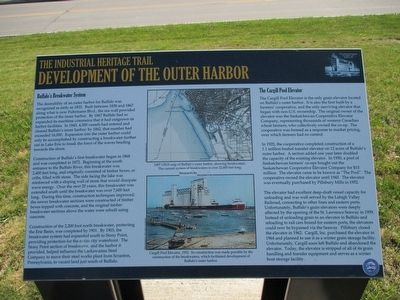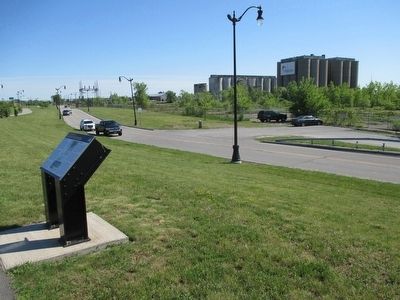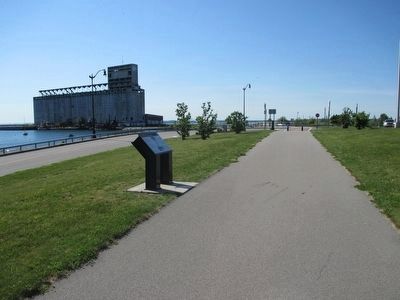South Park in Buffalo in Erie County, New York — The American Northeast (Mid-Atlantic)
Development of the Outer Harbor
The Industrial Heritage Trail
Buffalo's Breakwater System
The desirability of an outer harbor for Buffalo was recognized as early as 1835. Built between 1838 and 1867 along what is now Fuhrmann Blvd., the sea wall provided protection of the inner harbor. By 1867 Buffalo had so expanded its maritime commerce that it had outgrown its harbor facilities. In 1845, 4,500 vessels had entered and cleared Buffalo's inner harbor; by 1862, that number had exceeded 16,000. Expansion into the outer harbor could only be accomplished by constructing a breakwater further out in Lake Erie to break the force of the waves heading towards the shore.
Construction of Buffalo's first breakwater began in 1868 and was completed in 1872. Beginning at the south entrance to the Buffalo River, this breakwater was 2,400 feet long, and originally consisted of timber boxes, or cribs, filled with stone. The side facing the lake was reinforced with a sloping wall of stone that would dissipate wave energy. Over the next 20 years, this breakwater was extended south until the breakwater was over 7,600 feet long. During this time, construction techniques improved; the newer breakwater sections were constructed of timber boxes topped with concrete, and the original timber breakwater sections above the water were rebuilt using concrete.
Construction of the 2,200 foot north breakwater, protecting the Erie Basin, was completed by 1901. By 1903, the breakwater system had expanded south to Stony Point, providing protection for the entire city waterfront. The Stony Point section of breakwater, and the harbor it provided, helped influence the Lackawanna Steel Company to move their steel works plant from Scranton, Pennsylvania, to vacant land just south of Buffalo.
1907 USGS map of Buffalo's outer harbor, showing breakwaters. The current system of breakwaters is over 22,000 feet long. United States Geological Survey.
Cargill Pool Elevator, 1932. Its construction was made possible by the construction of the breakwaters, which facilitated development of Buffalo's outer harbor. National Geographic. Clifton Adams, photographer.
The Cargill Pool Elevator
The Cargill Pool Elevator is the only grain elevator located on Buffalo's outer harbor. It is also the first built by a farmer's cooperative, and the only surviving elevator that began with non-U.S. ownership. The original owner of the elevator was the Saskatchewan Cooperative Elevator Company, representing thousands of western Canadian wheat farmers, who collectively owned the co-op. The copperative was formed as a response to market pricing, over which farmers had no control.
In 1925, the cooperative completed construction of a 1.1 million bushel transfer elevator on 12 acres of Buffalo's outer harbor. A section added one year later doubled the capacity of the existing elevator. In 1930, a pool of Saskatchewan farmers' co-ops bought out the Saskatchewan Copperative Elevator Company for $15 million. The elevator came to be known as "The Pool". The cooperative owned the elevator until 1945. The elevator was eventually purchased by Pillsbury Mills in 1952.
The elevator had excellent deep-draft capacity for unloading and was well served by the Lehigh Valley Railroad, connecting to other lines and eatern ports. Unfortunately, Buffalo's grain elevators were deeply affected by the opening of the St. Lawrence Seaway in 1959. Instead of unloading grain to an elevator in Buffalo and reloading to rail cars bound for eastern ports, and the elevators could now be bypassed via the Seaway. Pillsbury closed the elevator in 1962. Cargill, Inc. purchased the elevator in 1964 and planned to use it as a winter grain storage facility. Unfortunately, Cargill soon left Buffalo and abandoned the elevator. Today, the elevator is stripped of all of its grain handling and transfer equipment and serves as a winter boat boat storage facility.
Erected by The Industrial Heritage Committee, Inc.
Topics. This historical marker is listed in these topic lists: Agriculture
• Industry & Commerce • Waterways & Vessels. A significant historical year for this entry is 1835.
Location. 42° 50.319′ N, 78° 51.434′ W. Marker is in Buffalo, New York, in Erie County. It is in South Park. Marker is at the intersection of Fuhrmann Boulevard and Tifft Street, on the right when traveling south on Fuhrmann Boulevard. Touch for map. Marker is in this post office area: Buffalo NY 14203, United States of America. Touch for directions.
Other nearby markers. At least 8 other markers are within walking distance of this marker. Environmental Remediation (approx. 0.3 miles away); Lake Erie (approx. 0.3 miles away); The Great Lakes (approx. 0.3 miles away); Early Lake Erie Water Craft (approx. 0.3 miles away); Improvements in Ship Design (approx. 0.3 miles away); The Union Ship Canal (approx. 0.3 miles away); The Lehigh Portland Cement Company (approx. 0.3 miles away); Bethlehem Steel in Lackawanna (approx. 0.3 miles away). Touch for a list and map of all markers in Buffalo.
Credits. This page was last revised on February 16, 2023. It was originally submitted on July 27, 2015, by Anton Schwarzmueller of Wilson, New York. This page has been viewed 460 times since then and 58 times this year. Photos: 1, 2, 3. submitted on July 27, 2015, by Anton Schwarzmueller of Wilson, New York.


